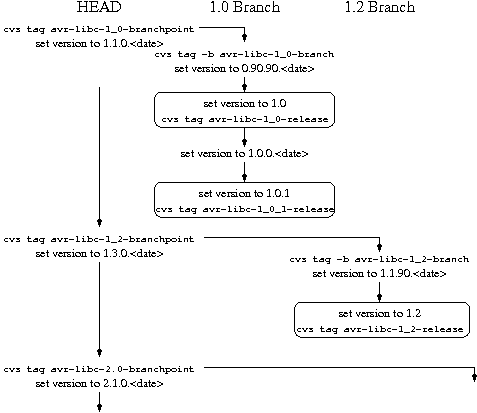| AVR Libc Home Page |  |
AVR Libc Development Pages | |||
| Main Page | User Manual | Library Reference | FAQ | Alphabetical Index | Example Projects |
| AVR Libc Home Page |  |
AVR Libc Development Pages | |||
| Main Page | User Manual | Library Reference | FAQ | Alphabetical Index | Example Projects |
Release numbers consist of three parts, a major number, a minor number, and a revision number, each separated by a dot.
The major number is currently 1 (and has always been). It will only be bumped in case a new version offers a major change in the API that is not backwards compatible.
In the past (up to 1.6.x), even minor numbers have been used to indicate "stable" releases, and odd minor numbers have been reserved for development branches/versions. As the latter has never really been used, and maintaining a stable branch that eventually became effectively the same as the development version has proven to be just a cumbersome and tedious job, this scheme has given up in early 2010, so starting with 1.7.0, every minor number will be used. Minor numbers will be bumped upon judgement of the development team, whenever it seems appropriate, but at least in cases where some API was changed.
Starting with version 1.4.0, a file <avr/version.h> indicates the library version of an installed library tree.
The information in this section is only relevant to AVR Libc developers and can be ignored by end users.
The following steps should be taken to cut a branch in SVN (assuming $username is set to your savannah username):
svn copy svn+ssh://$username@svn.savannah.nongnu.org/avr-libc/trunk svn+ssh://$username@svn.savannah.nongnu.org/avr-libc/tags/avr-libc-<major>_<minor>-branchpointsvn copy svn+ssh://$username@svn.savannah.nongnu.org/avr-libc/trunk svn+ssh://$username@svn.savannah.nongnu.org/avr-libc/branches/avr-libc-<major>_<minor>-branchsvn co svn+ssh://$username@svn.savannah.nongnu.org/avr-libc/branches/avr-libc-<major>_<minor>-branchA stable release will only be done on a branch, not from the SVN trunk.
The following steps should be taken when making a release:
svn switch svn+ssh://$username@svn.savannah.nongnu.org/avr-libc/branches/avr-libc-<major>_<minor>-branchsvn copy . svn+ssh://$username@svn.savannah.nongnu.org/avr-libc/tags/avr-libc-<major>_<minor>_<patch>-releasesvn copy svn+ssh://$username@svn.savannah.nongnu.org/avr-libc/branches/avr-libc-<major>_<minor>-branch svn+ssh://$username@svn.savannah.nongnu.org/avr-libc/tags/avr-libc-<major>_<minor>_<patch>-releaseThe following hypothetical diagram should help clarify version and branch relationships.

Release tree